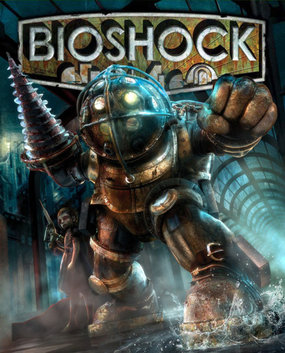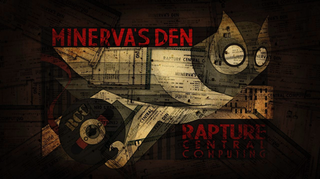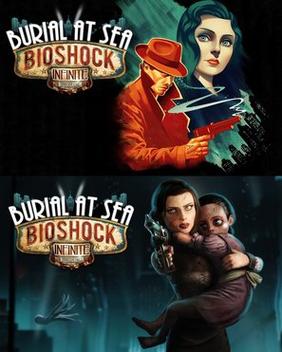
Kenneth M. Levine is an American game developer. He is the creative director and co-founder of Ghost Story Games. He led the creation of the BioShock series, and is also known for his work on Thief: The Dark Project and System Shock 2.

BioShock is a 2007 first-person shooter game developed by 2K Boston and 2K Australia, and published by 2K. The first game in the BioShock series, it was released for Microsoft Windows and Xbox 360 platforms in August 2007; a PlayStation 3 port by Irrational, 2K Marin, 2K Australia and Digital Extremes was released in October 2008. The game is set in 1960, and follows Jack, who discovers the underwater city of Rapture, built by business magnate Andrew Ryan to be an isolated utopia. The discovery of ADAM, a genetic material which grants superhuman powers, initiated the city's turbulent decline. Jack attempts to escape, fighting ADAM-obsessed enemies and Big Daddies, while engaging with the few sane humans that remain and learning of Rapture's past. The player, as Jack, can defeat foes in several ways by using weapons, utilizing plasmids that give unique powers, and by turning Rapture's defenses against them.

Mirror's Edge is a 2008 first-person action-adventure platform game developed by DICE and published by Electronic Arts. The game was released for PlayStation 3 and Xbox 360 in November 2008, and for Windows in January 2009. Set in a near-future city, it follows the story of Faith Connors, an underground parkour courier who transmits messages while evading government surveillance. To progress through the game, the player must control Faith from a first-person perspective and complete a series of levels that involve performing a sequence of acrobatic manoeuvres, including jumping between rooftops, running across walls, and sliding down zip lines.

BioShock 2 is a first-person shooter video game developed by 2K Marin and published by 2K Games. It was released worldwide for PlayStation 3, Windows, and Xbox 360 on February 9, 2010; Feral Interactive released an OS X version on March 30, 2012. The game takes place in the dystopian underwater city of Rapture, eight years after the events of BioShock. In the single-player campaign, players control the armored protagonist Subject Delta as he fights through Splicers—the psychotic human population of the city—using weapons and an array of genetic modifications. The game includes a story-driven multiplayer mode that takes place before the events of BioShock, during Rapture's civil war.

Dear Esther is an adventure video game developed and published by The Chinese Room. It was released for Microsoft Windows in February 2012 and OS X in May 2012. Ports for PlayStation 4 and Xbox One were released by Curve Digital in September 2016. First released in 2008 as a free modification for the Source game engine, the game was entirely redeveloped for a commercial release in 2012. Featuring minimalistic gameplay, the player's only objective in the game is to explore an unnamed island in the Hebrides, Scotland, listening to a troubled man read a series of letters to his deceased wife. Details of her mysterious death are revealed as the player moves throughout the island.

BioShock is a retrofuturistic video game series created by Ken Levine, published by 2K and developed by several studios, including Irrational Games and 2K Marin. The BioShock games combine first-person shooter and role-playing elements, giving the player freedom for how to approach combat and other situations, and are considered part of the immersive sim genre. Additionally, the series is notable for exploring philosophical and moral concepts with a strong in-game narrative influenced by concepts such as Objectivism, total utilitarianism, and American exceptionalism.
The Chinese Room is a British video game developer based in Brighton that is best known for exploration games, such as Dear Esther. The company originated as a mod team for Half-Life 2, based at the University of Portsmouth in 2007, and is named after John Searle's Chinese room thought experiment. In August 2018, it became a subsidiary of Sumo Digital.

The Wolf Among Us is an episodic graphic neo-noir mystery-drama adventure game developed by Telltale Games, based on Bill Willingham's Fables comic book series, to which it serves as a prequel. The game consists of five episodes that were released throughout 2013 and 2014. Retail versions for the PlayStation 3, PlayStation 4, PlayStation Vita, Xbox 360, and Xbox One consoles were made available in November 2014. In the game, players control Bigby Wolf, the sheriff of Fabletown – a clandestine community within 1980s New York City consisting of various fantastical characters from fairy tales and folklore – and must investigate a series of mysterious murders; the first ones to occur in Fabletown in a long time.

BioShock 2: Minerva's Den is a single-player downloadable content (DLC) campaign for the 2010 first-person shooter game BioShock 2, developed by 2K Marin and published by 2K Games. The player assumes the role of Subject Sigma, an armored and genetically modified human, or "Big Daddy"; Sigma must travel through Minerva's Den, the technological hub of the underwater city of Rapture, to download a schematic of the city's supercomputer. Gameplay is similar to that of BioShock 2, with new enemies and weapons.

Gone Home is a first-person exploration video game developed and published by The Fullbright Company. Gone Home was first released for Microsoft Windows, OS X, and Linux computers in August 2013, followed by console releases for the PlayStation 4 and Xbox One in January 2016, the Nintendo Switch in September 2018, and iOS in December 2018.

Until Dawn is a 2015 interactive drama horror video game developed by Supermassive Games and published by Sony Computer Entertainment for the PlayStation 4. Players assume control of eight young adults who have to survive on Blackwood Mountain when their lives are threatened. The game features a butterfly effect system in which players must make choices that may change the story. All playable characters can survive or die, depending on the choices made. Players explore the environment from a third-person perspective and find clues that may help solve the mystery.

BioShock Infinite: Burial at Sea is a two-part single-player expansion to the first-person shooter video game BioShock Infinite. It was developed by Irrational Games and published by 2K Games for PlayStation 3, OS X, Windows, Xbox 360, and Linux platforms. Episode One was released digitally on November 12, 2013, followed by Episode Two on March 25, 2014. A retail version was released as part of BioShock Infinite: The Complete Edition, and later included in BioShock: The Collection for PlayStation 4, Xbox One, and Nintendo Switch.

Tales from the Borderlands is an episodic interactive comedy graphic adventure sci-fi video game based on the Borderlands series. It was developed by Telltale Games under license from Gearbox Software, the developer of the Borderlands series, and 2K, its publisher. The game was released in November 2014 for Android, iOS, Microsoft Windows, OS X, PlayStation 3, PlayStation 4, Xbox 360, Xbox One, and in 2021 for Nintendo Switch.

Crypt of the NecroDancer is a roguelike rhythm game by Brace Yourself Games. The game takes fundamental elements of a roguelike dungeon exploration game and adds a beat-matching rhythm game set to an original soundtrack written by Danny Baranowsky. The player's actions are most effective when moving the character set to the beat of the current song and are impaired when they miss a beat, so it is necessary to learn the rhythmic patterns that the various creatures follow. The mixed-genre game includes the ability to import custom music, and the option to use a dance pad instead of traditional controllers or the keyboard. The game was released for Linux, OS X, and Windows in April 2015, being co-published by Klei Entertainment, for the PlayStation 4 and Vita in February 2016, for the Xbox One in February 2017, and for Nintendo Switch in February 2018. Crypt of the NecroDancer Pocket Edition, developed for iOS, was released in June 2016.

Dr. Jessica Curry is an English composer, radio presenter and former co-head of the British video game development studio The Chinese Room. She won a BAFTA award in 2016 for her score for the video game Everybody's Gone to the Rapture and received an honorary doctorate from Abertay University in 2023.

The Walking Dead: A New Frontier is an episodic graphic adventure video game based on the comic book series of the same name developed by Telltale Games. It is the sequel to The Walking Dead: Season Two, and the third game in The Walking Dead video game series. The first two episodes released on December 20, 2016, and a retail season pass disc edition released on February 7, 2017. The game employs the same narrative structure as the past seasons, where player choice in one episode will have a permanent impact on future story elements. The player choices recorded in save files from the first two seasons and the additional episode "400 Days" carry over into the third season.

Life Is Strange is an episodic adventure game developed by Dontnod Entertainment and published by Square Enix. The first installment of the Life Is Strange series, the game was released in five episodes periodically throughout 2015 for PlayStation 3, PlayStation 4, Windows, Xbox 360, and Xbox One. It was ported to OS X and Linux in 2016, and iOS and Android in 2017–2018.

Lara Croft Go is a turn-based puzzle video game in the Tomb Raider series. The player moves Lara Croft as a puzzle piece through a board game while avoiding obstacles and manipulating the environment. The developers distilled major series motifs, such as boulder-chases and reaction-based gameplay, to suit Lara Croft Go's time-independent gameplay. Square Enix Montréal developed the game as a spiritual successor to its 2014 Hitman Go, based on another Square Enix Europe franchise. It was released in August 2015 for Android, iOS, Windows, and Windows Phone devices. Versions for PlayStation 4, PlayStation Vita and Steam were released in December 2016.
Fragments of Him is a video game developed and published by Sassybot and released for Microsoft Windows and Xbox One on 3 May 2016 and 1 June 2016, respectively. The PlayStation 4 version was released on 26 September 2017.

Virginia is a 2016 first-person mystery adventure video game developed by Variable State and published by 505 Games. The game follows graduate FBI special agent Anne Tarver as she investigates her first case: the disappearance of a boy in rural Virginia.


















